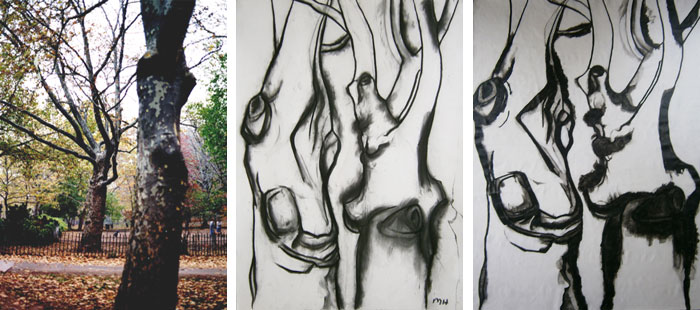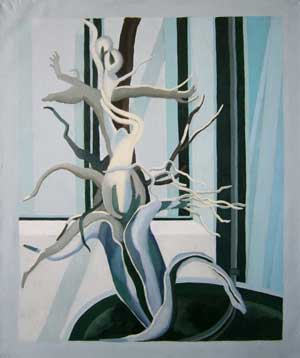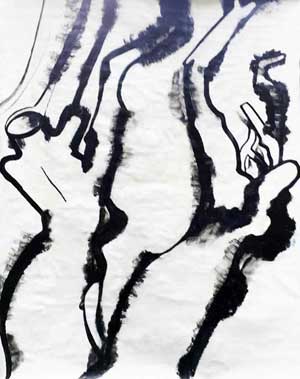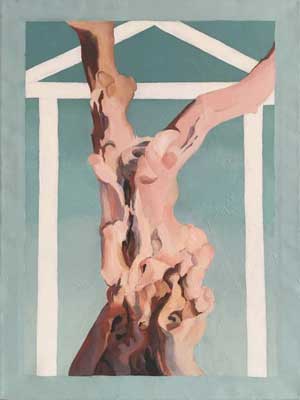
Mary Hrbacek, Close Call with Companion (digital photograph); Close Call, charcoal on paper, 22 x 33 in (drawing); Close Call IV, acrylic and gesso on canvas, 4 x 6 ft (painted drawing), 2019. A series of three media with one motif.
As a young girl growing up in Sweden Mary Hrbacek acquired an intimate love for nature. “My friends and I would do all kinds of things outdoors, from horseback and bicycle riding to ice skating on the Baltic Sea,” she says. Those activities had a profound effect on her life. “Even today I crave nature. I can’t do without it.”
A national culture that revered the outdoors only magnified the artist’s proclivities. Her father had migrated to Sweden from the family’s native United States for a position in the American Embassy when Hrbacek was 10 years old. “Swedes love nature,” she says. “They like silence and being alone on their own islands. Although I am half Irish and thus very social, I too love silence and being alone in my studio. So being an artist suits my personality.”
Today, Hrbacek’s identification with the natural world manifests in her best-known trope: haunting renditions of trees with human characteristics. “The similarities between human anatomy and tree forms in my work seem to create multiple meanings,” she says. “They test the boundaries between imagination and belief.”

Mary Hrbacek
Over the years Hrbacek (pronounced “HER-ba-check”) has exhibited her drawings and paintings in scores of shows, the latest being a presentation of 21 works that drew some 200 viewers to New York’s Elga Wimmer PCC earlier this year. Other noteworthy exhibits include a series of charcoal on paper drawings at the Museum of Contemporary Art of Crete and a solo show of tree paintings at New York’s Paris Koh Fine Arts. Earlier this year the artist won the Drawing Challenge II awarded by Jason McCoy Gallery, New York.
The Elga Wimmer PCC show, one of the artist’s largest to date, provided a viewing portal for Hrbacek’s ambitious new initiative: re-engineering the look and feel of charcoal tree sketches into works she refers to as “painted drawings.”
Just what is the nature of that look and feel? Hrbacek describes it as a “poetic suggestiveness that gives the works a sense of life in process.” Part of that poetry arises from the materials at hand: Ever since her youth the artist has responded to charcoal’s innate invitation to engage in a rubbing process that transforms surface representation into multi-layered suggestion. It is that very allusiveness that Hrbacek tries to recreate, she says, by “using paint in a brushy way like charcoal.”
The new works demand a wet medium partly for practical reasons: The artist wanted her painted drawings to be 4 ft x 6 ft—a size much larger than her usual 22 in x 33 in charcoal drawings. While charcoal is normally too powdery to use unprotected in large works, Hrbacek has always been fond of the medium and wanted to use it in some way, deciding to apply it as a kind of underlying blueprint of her image. Once she’s done with the charcoal she overlays it with a protective black acrylic as she further develops her image. For the requisite white she uses gesso, finding the cold tones of the more logical choice of acrylic too disruptive of the warmer black acrylic. In some of her works she furthers her desired transitional feel by applying a wash made from thick acrylic paint watered down to liquid form.

Mary Hrbacek, Twisted Naxos, 2016. Charcoal on paper, 22 x 30 in.
Together these constructive materials result in forms that are loosely defined rather than firmly delineated. “They feel as if they are in motion, part of the air that surrounds the works,” she says. In the Elga Wimmer PCC show the artist furthered her allusive ambitions by hanging the canvases loosely from the walls rather than stretching them. “I wanted to create a free-flowing look,” she says. “The feeling of freedom, of flowing naturally, continues my vision of work that is not too much defined.”
The sheer size of the finished works presented a physical challenge. “I worked on the floor so I had to use guards on my knees, ankles and wrists,” she says. “I try not to get right on the work, but sit on the side as much as I can. But the works are more delicate than I thought they would be, because they’re not stretched. So, they have to be handled carefully.”
One of her biggest problems, at least in the early creative rounds, was a tendency to use too much paint. “Maybe I was too nervous, but because these works were experimental I put on more paint than I should have,” she says. “As a result, I obscured some of the forms that were clear in the original drawings. And those forms defined the work.” She found herself removing some of the black acrylic paint that she had applied. “I scrubbed it off with paper towels and water and redefined it with some lines and brush marks that looked like charcoal.”
Has Hrbacek been successful in replicating the look and feel of her charcoal drawings in more ambitious works? Only partly, because constructive materials do cause a change in meaning. “The painted drawings are similar to the charcoal drawings,” she says. “But they can never be the same.”
The transformation of a mental image from drawing to painting completes a larger transformative journey from natural experience to formal creation. It often begins with a representational image. “When I am lucky enough to find a tree that has a human presence I shoot a photograph with my digital camera,” she says. “I later work from the resulting image, exploring the possibilities of its forms to see what I can do with them.” This procedure is part and parcel of the artist’s dependence on a live model. “I really do need a visual reference, to be looking at something,” she says. “I’m not good at making things up because the result tends to lack convincing details.”
Hrbacek usually proceeds from her initial photograph to an act of drawing which is a foundational process for the work to come. “Drawing comprises the skeleton and the structure that activate my work,” she says. “It provides movement, weight, focus and direction. It helps to clarify the work’s essence, which is a combination of feeling and form that originates within the work, which needs to be brought out and accentuated.”

Mary Hrbacek, Burgeoning, 2019. Acrylic on linen. 18 x 36 in.
In recent months Hrbacek has introduced new elements into her work: structural forms suggesting the restrictions humanity has placed upon nature. This formal advance finds its roots in the artist’s travels to Greece and France where she encountered anthropomorphic trees constrained by their environment. Some were growing inside pots; others were enclosed inside the walls of courtyards, restaurants and cafes. Hrbacek was struck by how these restrictions recalled a trauma experienced in her own life. When she was 15 her family returned to their original home in Virginia and to a culture more attuned to the shopping mall than the nature trail. The structures of a commercial civilization entombed the vitality of childhood. The artist’s life fell apart. “When we came to the United States I lost everything I loved,” she says. “And I could never find it again.”
Hrbacek wanted to express her restrictive theme without resorting to a stark and obtrusive statement. Rather than paint the trees’ café environments in realistic terms, she resorted once again to the semi-abstract. In her words: “I made the surroundings symbolic in an attempt to contrast a geometric architectural reference with the biomorphic.” These symbols took the shape of images unfamiliar to Hrbacek’s previous works: the occasional human form and the man-made artifact such as a floor, a piece of detailed cornice, or a slight architectural indication.
Hrbacek has borrowed some of these tropes from Francis Bacon, an artist she recently rediscovered for his mastery of such details. Bacon’s large semi-abstract windows and their suggestion of uncertainty hold a special appeal for Hrbacek. “Very often you don’t know what to think of one when you see it,” she says. “Is it a window? A door? Is it open? Shut? Does it lead outside?”
Hrbacek extends this ambivalence about limitation and freedom into the physical structures surrounding her trees. “I have made the courtyard’s stucco walls blue so they look a little bit like sky—but you can’t be sure. So, there’s a certain amount of play involved. The viewer might well ask, ‘Is this tree inside or outside?’ A courtyard, after all, is both in a way.” The resulting uncertainties, she believes, encourage reflection and draw the viewer into a cooperative co-creation of meaning.
This new initiative testifies to the artist’s continuing efforts to advance her skills and career. She credits her native determination to a childhood spent with parents devoid of communication and support. “A lack of love often creates drive, a quality which when combined with tenacity, enables artists to endure,” she says. “I have plenty of drive. It’s part of what pushed me to develop my talents.”

Mary Hrbacek, Tree-Dancers, 2019. Acrylic, gesso on canvas, 4 x 6 ft (approx).
Hrbacek’s move to New York City in the 1980s to pursue an art career testifies to her inner compulsion to succeed. “It was a huge risk,” she recalls. “I didn’t know if I had any talent.” The urban world’s concrete canyons presented an especially challenging environment for the nature-loving artist. She settled in Greenwich Village, later established a studio in the Brooklyn neighborhood of Greenpoint, and finally migrated to the Upper West Side of Manhattan. The neighborhood that is currently her home had more residential buildings and fewer studios—and the available ones were expensive. Rather than splurge on outrageous rent the artist took to plein-air, sketching during her walks in nearby Riverside Park. It was during these outings that her youthful experiences with nature bubbled to the surface, for she began to relate deeply with the trees. “I began to especially notice the Sycamores,” she says. “I started to get very excited about the texture and patterns of their bark.”
Hrbacek began sketching the trees in earnest. Then—an epiphany. “One day my vision suddenly changed,” she says. “I noticed that in some cases a tree’s knobs and limbs, their gestures and their very presence, seemed very human-like.” While not every tree possessed such characteristics, Hrbacek experienced what she refers to as a “poetic vision” for those that did. That vision manifested as bio-forms seemingly in transition between the worlds of humanity and nature.
The result differed from what most people view as reality, and Hrbacek sees that as a good thing. “My vision is a special one for my work, a way of representing my imagination,” she says. “Would other people see the same human forms as I see in a tree in nature? Maybe. But hopefully they will see them in my art.”
As this history suggests, Hrbacek’s aesthetic is driven more by intuitive engagement than structured principles. “I don’t sit down and think about my work and have a big philosophy about it,” she says. “I work intuitively and just let it happen. I like it to be physical and sensate with the materials that I work with as I follow my vision.”

Mary Hrbacek, Enclosed Torso, 2018. Acrylic on linen, 28 x 36 in.
If Hrbacek foregoes an overriding statement in her work she nevertheless welcomes viewers to create their own. “If somebody reads something into my work that’s all for the good,” she says. Such as? The artist has more than one answer, for she is in the habit of reflecting on her work as a kind of proxy viewer. One theme is a principle for which she titled one of her recent shows: “life before life” refers to a vital potential force energizing human beings. “We have traits and biological capabilities in our genetic material, that are part of our heritage and of our future,” she says. “They are a kind of ‘life before life’ inherent in the revitalization of our view of tree forms.”
That term “revitalization” suggests a second post hoc theme: rebirth. “Trees may serve as symbols of a universal thirst for redemption,” says Hrbacek. “They die and are reborn every year, just as in the Christian religion Jesus died and was reborn to redeem humanity.” The artist believes a redemptive theme, well documented in art history, can exist beyond the boundaries of any one religion. She puts it this way: “The upward movement and gestures of trees suggest they are imploring a God or a spirit to save them from death. They are seeking life in their emotional gestures.”
Hrbacek believes people would take better care of trees if their spiritual powers—and their connections with humanity–were more broadly perceived. Will the artist’s human-like trees, reaching as they do toward the stars, inspire greater environmental protection? Hrbacek believes the answer is “yes.” The tendency of people to nurture those with whom they empathize is, after all, well documented.
“I think the awareness that trees are complex beings connected to us by anatomical similarities would go far to create empathy and increase the likelihood for their survival in the human-dominated world,” says Hrbacek. “I hope my art makes a small contribution in this direction by stressing the organic roots of all living systems and our primal connection to the nature we have left behind in our high-tech world.”
Mary Hrbacek studied at the San Francisco Art Institute with Mary Lovelace O’Neal, Head of the Art Department at University of California Berkeley. She continued her studies at the Art Students League of New York. As a member of the International Association of Art Critics (AICA), Hrbacek contributes frequently to publications such as Whitehot Magazine, Artes Magazine, Culture Catch, and New York Art Beat.
Essay by Walter Idlewild
Images courtesy Mary Hrbacek
Posted May 16, 2020
Unattributed statements by Mary Hrbacek were recorded during interviews with Walter Idlewild in March and April 2020.

